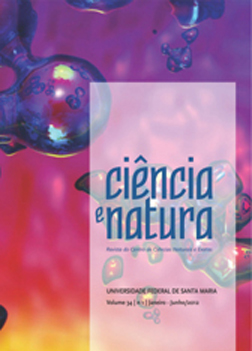Qualidade Biológica do Solo de Sistemas de Cultivo em Pomares de Citrus Deliciosa
DOI:
https://doi.org/10.5902/2179460X9355Resumo
A citricultura no RS é cultivada sob diversos sistemas de cultivos, sendo que o impacto destes na qualidade do solo é desconhecido. O objetivo deste estudo foi avaliar alguns índices de qualidade ambiental entre os diversos sistemas de manejo de citrus do Vale do Caí- RS com ênfase na produção de tangerinas ‘Montenegrina’ (Citrus deliciosa Tenore), através da caracterização química e biológica dos solos. As amostras foram coletadas em cinco áreas cultivadas sob diferentes sistemas de cultivo: sistema de cultivo orgânico (PO), cultivo orgânico em transição para biodinâmico (POT), cultivo agroflorestal (PAF), cultivo convencional (PC) e mata nativa (MN), no município de Montenegro, Rio Grande do Sul, a uma profundidade de 0-10 cm. Foram determinadas o Carbono da Biomassa Microbiana (CBM), a respiração basal (RB), as atividades da urease, da fosfatase ácida (FA) e a hidrólise do diacetato de fluoresceína (FDA). Para todas as avaliações, os resultados foram significativamente superiores na área de MN. Para o CBM, o sistema de MN obteve valores de 175,2 mg C Kg-1 de solo seco e o menor valor foi encontrado no sistema PC com 34 mg C Kg-1 de solo seco. Os valores de RB para o cultivo PAF (334,4 mg C-CO2 kg-1 solo seco), PO (333,3 mg C-CO2 kg-1 solo seco) e POT (257,7 mg C-CO2 kg-1 solo seco), foram significativamente menores nos valores de RB do sistema MN. Na avaliação da urease, os sistemas POT e PO foram significativamente inferiores apresentando valores de 77,7 e 68,5 µg N-NH4 g-1 solo seco 2 h-1 respectivamente, quando comparados ao sistema MN com valores de 128 µg N-NH4 g-1 solo seco 2 h-1. Para os sistemas de cultivo PC e PAF, os valores de FA obtidos foram quase três vezes menores (541 e 427 µg p-nitrofenol g-1 solo seco h-1 respectivamente) quando comparados com o sistema de MN. Portanto os sistemas de cultivo, mesmo os menos intensivos, não se mostraram capazes de manter a mesma qualidade microbiológica do solo que as áreas de MN da região. Isto mostra que indicadores de qualidade do solo como a RB, a FA e a urease podem ser indicadores importantes na avaliação da qualidade ambiental de diferentes sistemas de cultivo.
Downloads
Downloads
Publicado
Como Citar
Edição
Seção
Licença
Para acessar a DECLARAÇÃO DE ORIGINALIDADE E EXCLUSIVIDADE E CESSÃO DE DIREITOS AUTORAIS clique aqui.
Diretrizes Éticas para Publicação de Revistas
A revista Ciência e Natura está empenhada em garantir a ética na publicação e na qualidade dos artigos.
A conformidade com padrões de comportamento ético é, portanto, esperada de todas as partes envolvidas: Autores, Editores e Revisores.
Em particular,
Autores: Os Autores devem apresentar uma discussão objetiva sobre a importância do trabalho de pesquisa, bem como detalhes e referências suficientes para permitir que outros reproduzam as experiências. Declarações fraudulentas ou intencionalmente incorretas constituem comportamento antiético e são inaceitáveis. Artigos de Revisão também devem ser objetivos, abrangentes e relatos precisos do estado da arte. Os Autores devem assegurar que seu trabalho é uma obra totalmente original, e se o trabalho e / ou palavras de outros têm sido utilizadas, isso tem sido devidamente reconhecido. O plágio em todas as suas formas constitui um comportamento publicitário não ético e é inaceitável. Submeter o mesmo manuscrito a mais de um jornal simultaneamente constitui um comportamento publicitário não ético e é inaceitável. Os Autores não devem submeter artigos que descrevam essencialmente a mesma pesquisa a mais de uma revista. O Autor correspondente deve garantir que haja um consenso total de todos os Co-autores na aprovação da versão final do artigo e sua submissão para publicação.
Editores: Os Editores devem avaliar manuscritos exclusivamente com base no seu mérito acadêmico. Um Editor não deve usar informações não publicadas na própria pesquisa do Editor sem o consentimento expresso por escrito do Autor. Os Editores devem tomar medidas de resposta razoável quando tiverem sido apresentadas queixas éticas relativas a um manuscrito submetido ou publicado.
Revisores: Todos os manuscritos recebidos para revisão devem ser tratados como documentos confidenciais. As informações ou ideias privilegiadas obtidas através da análise por pares devem ser mantidas confidenciais e não utilizadas para vantagens pessoais. As revisões devem ser conduzidas objetivamente e as observações devem ser formuladas claramente com argumentos de apoio, de modo que os Autores possam usá-los para melhorar o artigo. Qualquer Revisor selecionado que se sinta desqualificado para rever a pesquisa relatada em um manuscrito ou sabe que sua rápida revisão será impossível deve notificar o Editor e desculpar-se do processo de revisão. Os Revisores não devem considerar manuscritos nos quais tenham conflitos de interesse resultantes de relacionamentos ou conexões competitivas, colaborativas ou outras conexões com qualquer dos autores, empresas ou instituições conectadas aos documentos.






